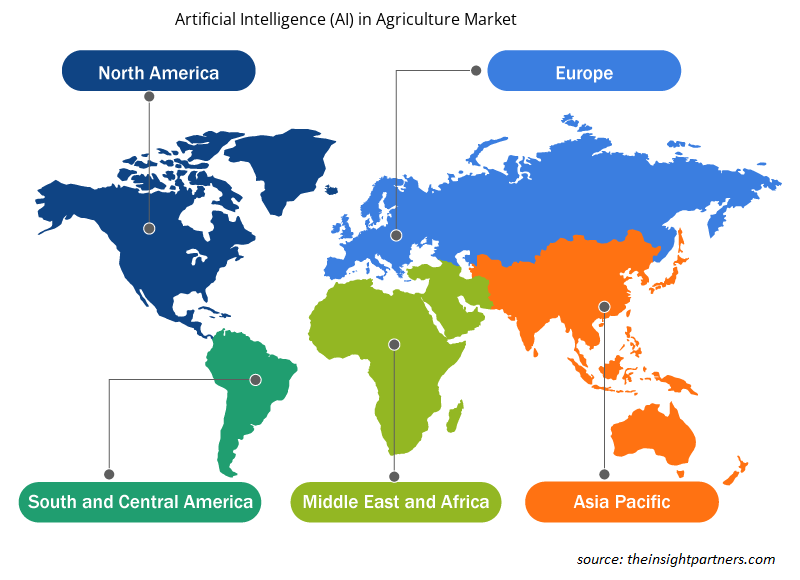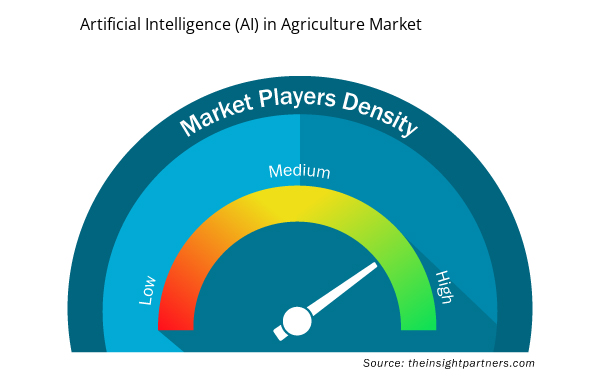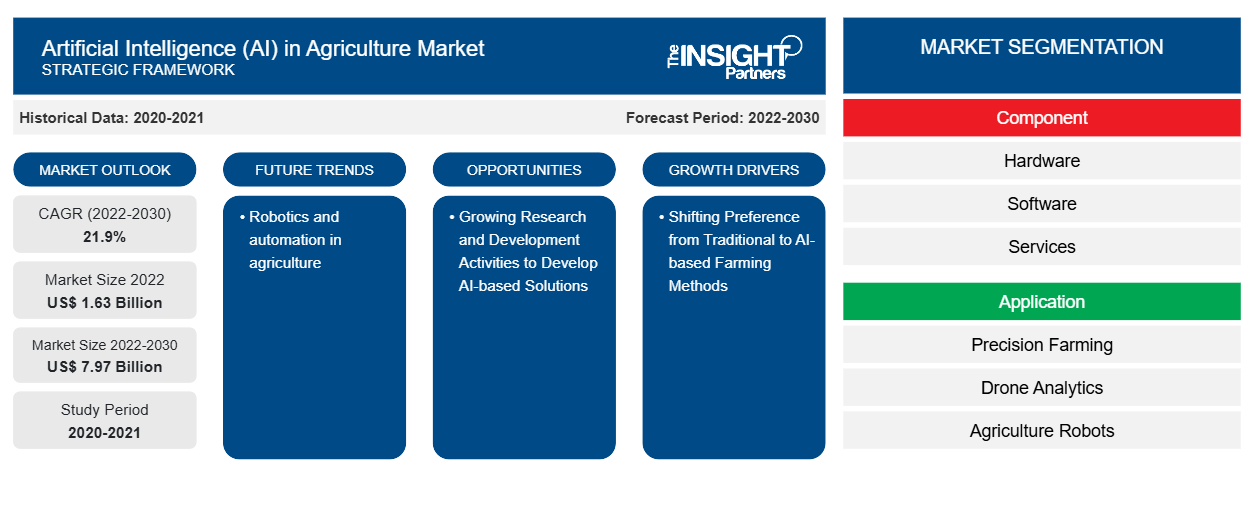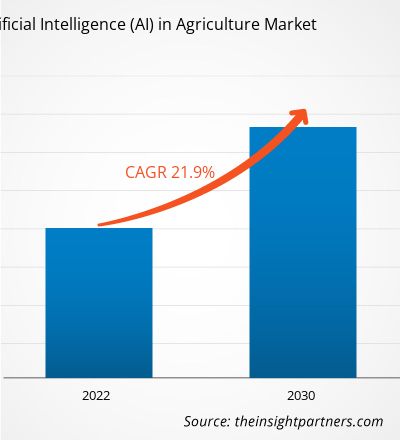農業における人工知能(AI)の市場規模は、2022年に16億3,000万米ドルと評価され、2030年までに79億7,000万米ドルに達すると予想されています。2022年から2030年にかけて21.9%のCAGRを記録すると予測されています。農業におけるロボット工学と自動化は、今後も市場の主要なトレンドであり続けると思われます。
農業市場分析における人工知能(AI)
伝統的な農法から AI ベースの農法への好みの移行、農業における無人航空機 (UAV) の使用の増加、農業におけるリアルタイム分析のニーズの高まりが、市場を牽引しています。AI ソリューションの実装に対する政府の支援が拡大しているため、予測期間中に市場が成長すると予想されています。さらに、AI ベースのソリューションを開発するための研究開発活動の増加とスマート農業の増加により、市場に有利な機会が生まれています。
農業における人工知能(AI)市場の概要
人工知能 (AI) は農業業界に革命を起こしています。予測分析、コンピューター ビジョン、機械学習、データ分析は、農業が障害を克服し、その可能性を最大限に引き出すのに役立ちます。農業で AI を使用すると、土壌の状態、気象パターン、作物の健康状態、履歴データなど、さまざまなソースからのデータの収集と分析が可能になります。
AI ベースのシステムは、収穫量を増やし、廃棄物を減らし、環境への懸念を最小限に抑えるための貴重な情報を農家に提供できます。農家と利害関係者は、データに基づく洞察とインテリジェントな意思決定を利用して、生産性を高め、リソースの使用を最適化し、農業上の問題に対処できます。スマートな機械とロボットを使用して、農業における単調な作業を自動化できます。これらの進歩は、農場が労働力不足に対処し、戦略的な計画と管理に集中するのに役立ちます。
要件に合わせてレポートをカスタマイズする
このレポートの一部、国レベルの分析、Excelデータパックなど、あらゆるレポートを無料でカスタマイズできます。また、スタートアップや大学向けのお得なオファーや割引もご利用いただけます。
- このレポートの主要な市場動向を入手してください。この無料サンプルには、市場動向から見積もりや予測に至るまでのデータ分析が含まれます。
農業における人工知能(AI)市場の推進要因と機会
伝統的な農法からAIベースの農法への好みの移行
カナダ全土の伝統的なジャガイモ栽培者は、作物の収穫量に直接影響を与える農業の重要な側面である栄養管理の課題に直面しています。従来の土壌処理と葉面施肥の方法は、ある程度は効果的ですが、特にジャガイモの成長後期に必要な栄養素に関しては限界があります。そのため、カナダ全土のジャガイモ栽培者は、ジャガイモの栄養ニーズを予測するためにAIソリューションを導入しています。たとえば、2023年11月には、農業分野で画期的な開発が行われており、カナダのジャガイモ栽培者は、作物の栄養ニーズをリアルタイムで監視および予測するためにAIに注目しています。このように、カナダの農家によるAIの採用は、農業市場におけるAIの成長を促進します。
AIベースのソリューションを開発するための研究開発活動の拡大
英国は世界トップクラスの技術と研究能力を誇り、AI を活用したソリューションの開発において世界をリードしています。さらに、英国の研究者は AI を活用して、農業などの伝統的な産業に革命を起こしています。2024 年 1 月のデータによると、ハーパー アダムス大学の研究者は、AI を活用して農業をより持続可能で生産性の高いものにしようとしています。
英国政府はまた、農業、ファッション、救急サービスなど、さまざまな分野での人工知能プロジェクトの開発を支援するために、3,982万ドルの資金提供を発表しました。さらに、中小企業の100件のプロジェクトの実現可能性調査に538万ドルが授与され、さまざまな分野で生産性を向上させる革新的なAIのアイデアを促進しています。したがって、このような政府の支援は、農業市場におけるAIの成長を促進すると予想されています。
農業市場レポートにおける人工知能(AI)のセグメンテーション分析
農業市場分析における人工知能 (AI)の導出に貢献した主要なセグメントは、コンポーネントとアプリケーションです。
- 農業市場における人工知能(AI)は、コンポーネントに基づいて、ハードウェア、ソフトウェア、サービスに分かれています。ハードウェアセグメントは、2022年に大きな市場シェアを占めました。
- 用途別に見ると、市場は精密農業、ドローン分析、農業ロボット、家畜監視などに分かれており、2022年には精密農業分野がより大きな市場シェアを占めました。
農業における人工知能 (AI) の地域別市場シェア分析
農業市場における人工知能 (AI) レポートの地理的範囲は、主に北米、アジア太平洋、ヨーロッパ、中東およびアフリカ、南米および中米の 5 つの地域に分かれています。
アジア太平洋地域の市場は、技術的に高度なソリューションに対する需要の高まりにより、予測期間中に拡大すると予測されています。農業従事者の高齢化が急速に進んでいるオーストラリアなどの国では、熟練労働者の需要がかつてないほど高まっています。AIや機械学習などの最先端技術を統合した農業は、このギャップを埋め、農業を現代化するための鍵を握っています。オーストラリアの農家の多くは、すでにAIを活用したシステムのメリットを実感しています。たとえば、2023年10月、ワムランのサンレイストロベリーはDeepBerry自動監視システムを導入しました。このシステムは、視覚と赤外線の両方の画像を使用して、熟度、傷、菌類、果実の大きさ、形状、異物などを正確に検出します。1時間あたり7,000以上のガンネットを処理できます。このような自動化システムの実装は、農業市場におけるAIの成長を促進します。
農業市場における人工知能(AI)の地域別洞察
予測期間を通じて農業市場における人工知能 (AI) に影響を与える地域的な傾向と要因は、Insight Partners のアナリストによって徹底的に説明されています。このセクションでは、北米、ヨーロッパ、アジア太平洋、中東、アフリカ、南米、中米にわたる農業市場における人工知能 (AI) のセグメントと地理についても説明します。

- 農業市場における人工知能(AI)の地域別データを入手
農業市場レポートのスコープにおける人工知能(AI)
| レポート属性 | 詳細 |
|---|---|
| 2022年の市場規模 | 16億3千万米ドル |
| 2030年までの市場規模 | 79億7千万米ドル |
| 世界のCAGR(2022-2030年) | 21.9% |
| 履歴データ | 2020-2021 |
| 予測期間 | 2022-2030 |
| 対象セグメント | コンポーネント別
|
| 対象地域と国 | 北米
|
| 市場リーダーと主要企業プロフィール |
|
農業市場における人工知能(AI)のプレーヤー密度:ビジネスダイナミクスへの影響を理解する
農業市場における人工知能 (AI) 市場は、消費者の嗜好の変化、技術の進歩、製品の利点に対する認識の高まりなどの要因により、エンドユーザーの需要が高まり、急速に成長しています。需要が高まるにつれて、企業は提供を拡大し、消費者のニーズを満たすために革新し、新たなトレンドを活用し、市場の成長をさらに促進しています。
市場プレーヤー密度とは、特定の市場または業界内で活動している企業または会社の分布を指します。これは、特定の市場スペースに、その規模または総市場価値と比較して、どれだけの競合相手 (市場プレーヤー) が存在するかを示します。
農業市場における人工知能 (AI) に取り組んでいる主要企業は次のとおりです。
- トゥーレテクノロジーズ
- プレシジョンホーク株式会社
- イージートゥーシーアグテックSL
- ディア&カンパニー
- クライメートLLC
- ガマヤSA
免責事項:上記の企業は、特定の順序でランク付けされていません。

- 農業市場における人工知能(AI)のトップキープレーヤーの概要を入手
農業市場における人工知能(AI)のニュースと最近の動向
農業市場における人工知能 (AI) は、主要な企業出版物、協会データ、データベースを含む一次および二次調査後の定性的および定量的データを収集することによって評価されます。農業市場における人工知能 (AI) の開発のいくつかを以下に示します。
- Chipotle Mexican Grill は、Greenfield Robotics と Nitricity への少数投資を発表しました。Chipotle からの投資により、Greenfield Robotics はロボットの保有台数を拡大し、マイクロスプレー、カバークロップの植え付け、土壌検査などの追加機能を開発できるようになります。(出典: Chipotle Mexican Grill、企業ウェブサイト、2023 年 12 月)
農業市場における人工知能 (AI) レポートの対象範囲と成果物
「農業における人工知能(AI)の市場規模と予測(2020〜2030年)」レポートでは、以下の分野をカバーする市場の詳細な分析を提供しています。
- 調査対象範囲に含まれるすべての主要市場セグメントについて、農業における人工知能(AI)の市場規模と世界、地域、国レベルでの予測
- 農業市場における人工知能(AI)の動向、推進要因、制約、主要な機会などの市場動向
- 詳細なPEST/ポーターの5つの力とSWOT分析
- 主要な市場動向、世界および地域の枠組み、主要プレーヤー、規制、最近の市場動向を網羅した農業市場分析における人工知能(AI)
- 農業市場における人工知能(AI)の市場集中、ヒートマップ分析、主要プレーヤー、最近の動向を網羅した業界展望と競争分析
- 詳細な企業プロフィール
- 過去2年間の分析、基準年、CAGRによる予測(7年間)
- PEST分析とSWOT分析
- 市場規模価値/数量 - 世界、地域、国
- 業界と競争環境
- Excel データセット



Report Coverage
Revenue forecast, Company Analysis, Industry landscape, Growth factors, and Trends

Segment Covered
This text is related
to segments covered.

Regional Scope
North America, Europe, Asia Pacific, Middle East & Africa, South & Central America

Country Scope
This text is related
to country scope.
よくある質問
Shifting preference from traditional to AI-based farming methods is the major factors that propel the global artificial intelligence (AI) in agriculture market.
North America dominated the artificial intelligence (AI) in agriculture market in 2023.
The global artificial intelligence (AI) in agriculture market is estimated to register a CAGR of 21.9% during the forecast period 2023–2031.
The global artificial intelligence (AI) in agriculture market is expected to reach US$ 9.48 billion by 2031.
Robotics and automation in agriculture to play a significant role in the global artificial intelligence (AI) in agriculture market in the coming years.
The key players holding majority shares in the global artificial intelligence (AI) in agriculture market are Tule Technologies Inc, PrecisionHawk Inc, Easytosee Agtech SL, Deere & Co, Climate LLC, Gamaya SA, International Business Machines Corp, Microsoft Corp, Prospera Technologies Ltd, and Taranis.
Trends and growth analysis reports related to Technology, Media and Telecommunications : READ MORE..
The Insight Partners performs research in 4 major stages: Data Collection & Secondary Research, Primary Research, Data Analysis and Data Triangulation & Final Review.
- Data Collection and Secondary Research:
As a market research and consulting firm operating from a decade, we have published and advised several client across the globe. First step for any study will start with an assessment of currently available data and insights from existing reports. Further, historical and current market information is collected from Investor Presentations, Annual Reports, SEC Filings, etc., and other information related to company’s performance and market positioning are gathered from Paid Databases (Factiva, Hoovers, and Reuters) and various other publications available in public domain.
Several associations trade associates, technical forums, institutes, societies and organization are accessed to gain technical as well as market related insights through their publications such as research papers, blogs and press releases related to the studies are referred to get cues about the market. Further, white papers, journals, magazines, and other news articles published in last 3 years are scrutinized and analyzed to understand the current market trends.
- Primary Research:
The primarily interview analysis comprise of data obtained from industry participants interview and answers to survey questions gathered by in-house primary team.
For primary research, interviews are conducted with industry experts/CEOs/Marketing Managers/VPs/Subject Matter Experts from both demand and supply side to get a 360-degree view of the market. The primary team conducts several interviews based on the complexity of the markets to understand the various market trends and dynamics which makes research more credible and precise.
A typical research interview fulfils the following functions:
- Provides first-hand information on the market size, market trends, growth trends, competitive landscape, and outlook
- Validates and strengthens in-house secondary research findings
- Develops the analysis team’s expertise and market understanding
Primary research involves email interactions and telephone interviews for each market, category, segment, and sub-segment across geographies. The participants who typically take part in such a process include, but are not limited to:
- Industry participants: VPs, business development managers, market intelligence managers and national sales managers
- Outside experts: Valuation experts, research analysts and key opinion leaders specializing in the electronics and semiconductor industry.
Below is the breakup of our primary respondents by company, designation, and region:

Once we receive the confirmation from primary research sources or primary respondents, we finalize the base year market estimation and forecast the data as per the macroeconomic and microeconomic factors assessed during data collection.
- Data Analysis:
Once data is validated through both secondary as well as primary respondents, we finalize the market estimations by hypothesis formulation and factor analysis at regional and country level.
- Macro-Economic Factor Analysis:
We analyse macroeconomic indicators such the gross domestic product (GDP), increase in the demand for goods and services across industries, technological advancement, regional economic growth, governmental policies, the influence of COVID-19, PEST analysis, and other aspects. This analysis aids in setting benchmarks for various nations/regions and approximating market splits. Additionally, the general trend of the aforementioned components aid in determining the market's development possibilities.
- Country Level Data:
Various factors that are especially aligned to the country are taken into account to determine the market size for a certain area and country, including the presence of vendors, such as headquarters and offices, the country's GDP, demand patterns, and industry growth. To comprehend the market dynamics for the nation, a number of growth variables, inhibitors, application areas, and current market trends are researched. The aforementioned elements aid in determining the country's overall market's growth potential.
- Company Profile:
The “Table of Contents” is formulated by listing and analyzing more than 25 - 30 companies operating in the market ecosystem across geographies. However, we profile only 10 companies as a standard practice in our syndicate reports. These 10 companies comprise leading, emerging, and regional players. Nonetheless, our analysis is not restricted to the 10 listed companies, we also analyze other companies present in the market to develop a holistic view and understand the prevailing trends. The “Company Profiles” section in the report covers key facts, business description, products & services, financial information, SWOT analysis, and key developments. The financial information presented is extracted from the annual reports and official documents of the publicly listed companies. Upon collecting the information for the sections of respective companies, we verify them via various primary sources and then compile the data in respective company profiles. The company level information helps us in deriving the base number as well as in forecasting the market size.
- Developing Base Number:
Aggregation of sales statistics (2020-2022) and macro-economic factor, and other secondary and primary research insights are utilized to arrive at base number and related market shares for 2022. The data gaps are identified in this step and relevant market data is analyzed, collected from paid primary interviews or databases. On finalizing the base year market size, forecasts are developed on the basis of macro-economic, industry and market growth factors and company level analysis.
- Data Triangulation and Final Review:
The market findings and base year market size calculations are validated from supply as well as demand side. Demand side validations are based on macro-economic factor analysis and benchmarks for respective regions and countries. In case of supply side validations, revenues of major companies are estimated (in case not available) based on industry benchmark, approximate number of employees, product portfolio, and primary interviews revenues are gathered. Further revenue from target product/service segment is assessed to avoid overshooting of market statistics. In case of heavy deviations between supply and demand side values, all thes steps are repeated to achieve synchronization.
We follow an iterative model, wherein we share our research findings with Subject Matter Experts (SME’s) and Key Opinion Leaders (KOLs) until consensus view of the market is not formulated – this model negates any drastic deviation in the opinions of experts. Only validated and universally acceptable research findings are quoted in our reports.
We have important check points that we use to validate our research findings – which we call – data triangulation, where we validate the information, we generate from secondary sources with primary interviews and then we re-validate with our internal data bases and Subject matter experts. This comprehensive model enables us to deliver high quality, reliable data in shortest possible time.


 このレポートの無料サンプルを入手する
このレポートの無料サンプルを入手する